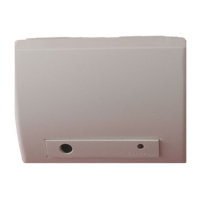9 Glass Break Functional Test
The SMCGB10-Z detects the breaking of framed
glass mounted in an outside wall. Testing the
sensor with unframed lass, broken bottles, and
so on, may not trip the sensor. The sensor
typically does not trip to glass breaking in the
middle of the room. In rooms where multiple
sounds can reflect and duplicate the glass-break
frequency pattern.
The Pattern Recognition Technology of the
sensor ignores most false alarm sounds, including
glass break testers. To test the sensor, use test
mode.
Test mode disables glass break pattern
processing in upper and lower frequencies. The
sensor is then listening only for the mid-range
frequencies that the hand-held tester
reproduces. It’s the mid-range frequencies that
determine sensor range.
Test Mode
To put the sensor in test mode:
A. Set the Touchscreen to sensor test mode.
B. Use a Sentrol 5709C handheld tester to put
the sensor into test mode. Set the tester to
tempered glass and hold the tester on top of
the sensor.
C. Activate the tester. The sensor will alarm,
then go into test mode for one minute. In
test mode, the LED blinks continuously. To
extend test time, fire the tester at the
sensor at least once a minute.
Testing the Sensor
To test the sensor while in test mode:
A. The tester has a different setting for each
type of glass. Set the tester for tempered or
laminated glass unless you are certain that
all the glass to be protected is plate glass.
B. Hold the tester near the surface of the glass
to be protected and aim the speaker at the
sensor. Be sure the tester is at the point on
the glass farthest from the detector. If
closed drapes or curtains are present, hold
the tester behind them.
C. Press the test button on the tester. The LED
on the sensor goes ON for 4 seconds to
indicate the glass is within detection range
of the sensor. If the LED does not stay ON for
4 seconds, move the sensor and retest.
If the sensor will not activate within its stated
range of coverage, check for battery strength in
the tester. A new tester battery will likely
restore range. You may need to use additional
sensors to achieve adequate coverage.
The sensor automatically changes from test
mode to normal mode approximately one minute
after it last hears the tester. In normal mode the
LED does not blink unless it hears a loud sound.
In normal mode, the sensor does not trip to the
tester, unless the tester is held next to the
sensor. Each time the sensor alarms, it also goes
into test mode for one minute.
Room acoustics can artificially extend the range
of a glass break sensor. The specified range of
the sensor has been established for worst-case
conditions. While the sensor will likely function
at additional range, it may miss a minimum
output break, or room acoustics may change at
some future time, bringing the sensor range back
into normal 20 ft. (6 m) conditions. Do not
exceed the rated range of the sensor, regardless
of what the tester shows.

